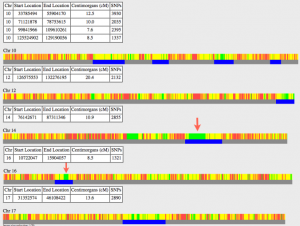
One of Irish genealogy’s dirty little secrets is that it’s all very simple. We do like to dress up in fancy complications – a valuator’s codebook here, a tithe defaulter there. And if we’re genetic genealogists we really really love our tight-fitting hermetic acronyms and our spangly centi-morgans.
Really, though, the logic behind research is as elementary as an infant’s building blocks. Pile one record on top of another until you can’t go any further. And that’s it. Yes, there are little bits of lateral thinking that can sometimes get around an obstacle. But it’s not brain surgery. It’s not even rocket science.

Another little secret is the fact that many of the processes we use are deeply repetitive and, frankly, stupid. Identify a townland. Find the civil parish. Match the Catholic parish. Do it again. Do it again.
The impulse to automate this stuff before going mad with boredom is the main motivator behind the programming I do. It’s the motivation behind the latest addition to this site, an attempt to map the numbers of householders in the civil parishes of Griffith’s Valuation onto the matching Catholic parishes. Here’s Gilshennan, for example.
The aim was to provide quick-and-dirty access to information on the Catholic records covering areas where particular families were living around the 1850s. Quick maybe, dirty certainly. Catholic and civil parishes don’t correspond precisely, which has thrown up lots of oddities. For instance, if there were seven Grenham households recorded by Griffith in the civil parish of Kilmore, and the civil parish of Kilmore is divided between the Catholic parishes of Castlemore and Kilbeg, then the map displays seven Grenham households in each parish, seven in Castlemore and seven in Kilbeg. Talk about Reproductive.
I’ve plastered the thing in disclaimers, but I have doubts about its usefulness. At the very least it shows that even if Irish genealogy isn’t that complicated it can still get pretty weird.
Just would like your thought as to how men and women found mates . Some towns were quite small so choices were limited. My thought is that choices were limited to the distance your feet would carry you. Horses were quite expensive and probably out of range financially . The average person walks 3 1/2 miles per hour so an 8 hour walk which is quite a journey gives you a 25 mile radius….your feet would be quite sore not to mention the weather …. or perhaps they were arranged by relatives
Where possible, I try to identify the properties where families were living, and more than once, I’ve found future husband and wife living nearby. Where they are a bit further from each other, it may still be possible to see a connection, eg through the fathers’ trades.
The extract below from a fictional tale from 1852 shows how young folk carried on at a country funeral, and details quite a number of the courting games they played, which I found very interesting. The author was a country boy.
As one of the characters says “it’s no wonder that Ireland’s full of people; for I believe they do nothing but coort from the time they’re the hoith of my leg”.
https://1drv.ms/b/s!AjooUIUtx9j5hKRmwaHfFG5pfhNSJA
True enough. My great grandmother was, I believe, from Kilmactigue or Aclare, and my great grandfather seems to have been from Kilmovee or Charlestown.
A good day’s ride on Shanks’s mare, either way. I think there must have been SOME arrangements made by someone, but who knows but there might have been a middle distant marketplace or???
Please keep digging. I will.
OT, did you work on my R wrist 05/02/2012? It’s NOT 100%, but it works a lot better than it might have. Thanks!
Good thoughts. While looking for records for my Keelan Farrelly families I found one Catholics church record in Kingscourt, Rathlohan for a John Keelan and Margaret Clarke with notes “granted Episcopal dispensation” I assume they were related but have yet to find that thread. Anyone who can assist is most welcomed. His parents were Terence Keelan and Anne Farrelly. May the force be with you
Tut-tut, John! “Householders” in Griffiths? That myth was debunked two decades ago…please don’t resurrect it now.
As even you have referred to previously, Griffiths records plots of land and who holds them, whether a house exists or not. Thus, not every plot results in a household, which also means that several plots may be held by one individual…thus one household.
You’re right, keep plastering those disclaimers!
Tut-tut, Steve! Not paying attention? The counts done on my site are of those recorded as householders (i.e. occupying a house) in Griffith’s, not a simple index count.
A disclaimer, please? Or a retraction?
Ah! Lack of clarity then…as you know, one needs to proclamation as well as disclaim in Irish genealogy!!
I had a similar situation ,as i could not fathom out how my grandmother and grandfather met. as she came from Tralee and my grandfather came from Kildare . The railway brought them together. as i discovered. So could that answer some of the questions people in the late eighteen hundreds .
I feel dense in asking this, but from the home page what is the navigation to get to the functionality described in the article/example?
Just enter a surname at https://www.johngrenham.com/surnames/ and (if the surname is listed as a householder in Griffith – i.e. as occupying a house) you should see a link to the map in the map navigation panel, something like “Murphy households by Catholic parish: new! “
Three pairs of my great-grandparents married in Ireland in 1885, 1888 and 1894. The 1885 married at the bride’s home in Knopogge, Ardnageehy civil parish Watergrasshill Catholic parish County Cork. The groom was from adjacent Lyravvarrig townland. The 1888 couple married at Eskra chapel in Clogher parish, County Tyrone. The bride was from NewtownSaville village and the groom from adjacent Tullanafoile townland. I assume these two couples knew each rather closely before the marriages. The third couple were from different sides of Cork City growing up; he from Massytown, Macroom and she from Beennaskehy townland, Monanimy civil parish and Killavullen Catholic parish. Their addresses in Cork City were 59 Dublin Street and 70 York Street. Google maps shows the distance is about 2.0-2.5 km. You can only marry someone if you occupy the same room for the ceremony so you may as well have married someone close by. You would know the family and their reputation and they’d know yours.